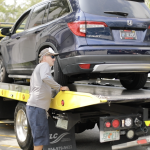A Business Relocation Checklist (Including Auto Transport for Business Fleets)
If you’re planning on moving your business, the key to success is planning ahead and creating a checklist that acts as a guide throughout the moving process. While every move has its unique challenges, the following business relocation checklist covers the main areas of consideration.
For businesses with fleets, it’s worth considering the advantages of finding an experienced, professional vehicle transport service that can handle cars, trucks, SUVs, vans and other vehicle types involved with auto transport for business fleets. It’s especially important to work with companies that have experience managing moves for professional organizations.
Six Months Before Move
Read the current lease. Read your current lease to determine if there are any potential snags with your planned move date.
Budget. Establish a preliminary budget for your business relocation. Keep it as realistic as possible by researching the costs of business relocation, including transporting vehicles.
Team. Put together a team who will handle different areas of the move. Those include communication with employees, hiring movers and auto transportation, packing, and setting up the new office. Involve at least one upper level manager on these teams.
Get quotes. Look for moving companies with a track record in handling your type of move. They also should offer all the services you need. Those include junk removal and storage.
Auto transport for business fleets. Contact auto transport companies if you have a fleet to move. Look for companies with experience in shipping an entire professional organization’s fleet and who offer door-to-door shipping as well as discounts for large organizations.
Two to Four Months Before the Move
Coordination with IT. Work with the IT department on timelines to move servers, desktop computers, and PBX.
Name Move Liaisons. Designate a move liaison within each department to work with the Move Team. This keeps everyone on the same page and ensures that any special needs of a department are met.
Move Team meetings. Begin holding weekly Move Team meetings to work out details with each department on scheduling the move.
Set Date. Set a definitive move date so that all planning can focus on that day. Also, notify the landlord of your intention to vacate your current building.
Communicate. Notify all employees of the move. Begin setting up a move schedule for each department. Designate people to establish deadlines for move-related tasks, such as setting up phone lines, computer networks, desks and office furniture, break room items, etc.
Layout plan. Create a detailed layout for where office furniture will go in the new building.
Employee badges. Designate members of the Move Team to focus on creation of new employee security badges, building access cards and parking lot permits for the new location.
One Month Before the Move
Move packets. Create packets for employees explaining what is expected of them to do for the move (such as clearing out desks, how to pack personal items, etc.).
Create a tagging scheme. Develop labels, tags or numbers for boxes that correspond with the correct floor and layout plan in the new building.
Discontinue current services. This includes security and cleaning services, landscaping companies, food vendors, and more. Notify them of your move out day so they can terminate services after you leave.
Prepare a press release. The communications team should prepare a press release and other materials to make a public statement about the move, informing consumers and business partners of your new location. Also, update the following with new address information.
- Business Accounts
- Company Website
- Social Media
- Banks & Financial Institutions
- Accounts Receivable & Payable
- Listings on Google & Review Sites
Two Weeks Before Move
At this point, most of the actions moving forward build on what has already been set up in previous steps.
- Finalize plans with the Move Team and department moving liaisons
- Order all building access cards, parking permits, keys for the office, and security badges
- Double check with IT to confirm all computer-related installations
- Confirm internet service and phone service
- Prepare welcome packets to the new location for employees
- Select a cleaning service for your current location (unless the landlord handles that issue)
- Schedule training for emergency procedures at the new location
- This is also the last chance to throw out any old furniture and equipment you will not need in the new building
On Moving Day
- Assign personnel to answer questions and offer support to employees at both the current and new office building
- Allocate security badges, parking permits, and card keys as people arrive
- Distribute employee welcome packets
- Set up new office based on the layout plan made in advance and make any adjustments as needed
- Walk through the old building to document any damages
Post-Move Tasks
After the move is over, there are still some items to address.
- Have members of the Move Team focus on checking with all teams to see if there are any challenges that need to be immediately resolved
- Collect all badges, card keys, and other security related items from the old building
- Review all the final invoices from service providers at the old building before payout
These cover many of the biggest issues involved with a business relocation, including finding the right auto transport for business fleets. Keep them in mind and it will make your move that much easier to manage.






Comments by Direct Connect Auto Transport